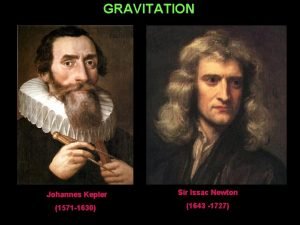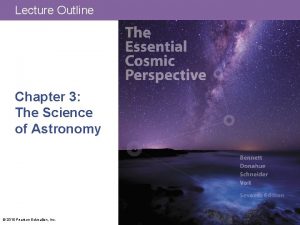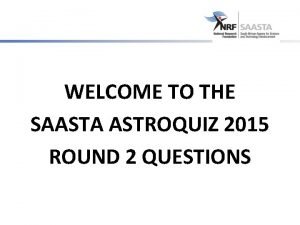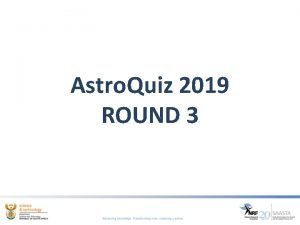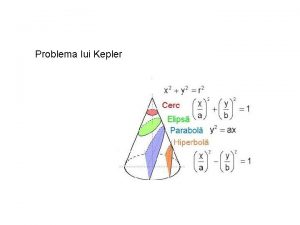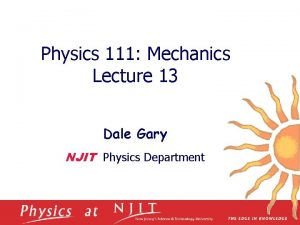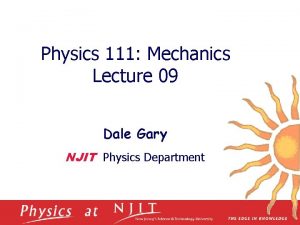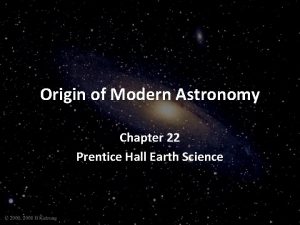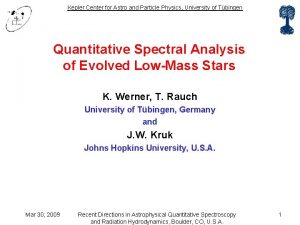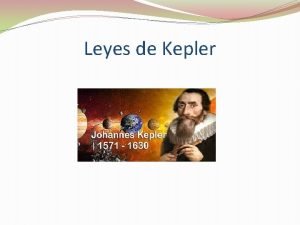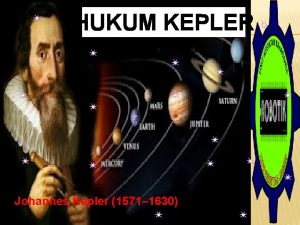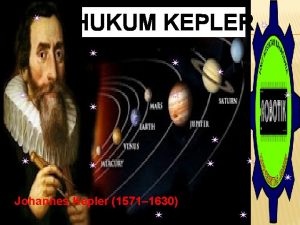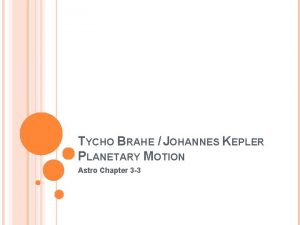INTRO TO ASTRO Lesson 6 Kepler and the
















- Slides: 16

INTRO TO ASTRO Lesson 6 Kepler and the Laws of Planetary Motion

ANOTHER THOUGHT EXPERIMENT • Imagine you have made a discovery that changes the scientific world view, but goes against everything that has been TRUE for 1400 years. • Would you feel compelled to reveal it? Despite repercussions? Even if it changed the way YOU view the world?

• Kepler mastered, like the best scientists, the most complicated technical issues, especially in astronomy, but he always emphasized his philosophical, even theological, approach to the questions he dealt with: God manifests himself not only in the words of the Scriptures but also in the wonderful arrangement of the universe and in its conformity with the human intellect. Thus, astronomy represents for Kepler, if done philosophically, the best path to God (see Hübner 1975; Methuen 1998 and 2009; Jardine 2009).

JOHANNES KEPLER • Worked as an assistant of Tycho Brahe • Closely studied the orbit of Mars under Brahe which lead to his formation of the laws of planetary motion Observed and documented supernova of 1604 • • Meticulous observer and recorder of the cosmos, in particular our solar system

KEPLER • Kepler endorsed Copernican model of solar system • Copernican model still couldn’t accurately predict period and speed of the planets • • Why? Why would this matter?

ELLIPSES • Properties of ellipses: • Ellipses have two foci which determine its shape, the further apart the foci, the flatter the ellipse

ELLIPSES • The amount of "flattening" of the ellipse is termed the eccentricity. • Ellipses have eccentricities lying between zero and one

ELLIPSES • The long axis of the ellipse is called the major axis, while the short axis is called the minor axis (adjacent figure). Half of the major axis is termed a semimajor axis.

DATA DRAMA • After Brahe’s death, Kepler was able to obtain his data. However, he did so by less than legal means, thwarting Brahe’s family out of their inheritance And it was fortunate for the development of modern astronomy that he did! Kepler was able to determine the orbits of each planet using triangulation • •

1 ST LAW • The orbits of the planets are ellipses, with the Sun at one focus of the ellipse. http: //astro. unl. edu/classaction/animations/renaiss ance/kepler. html

2 ND LAW • The line joining the planet to the Sun sweeps out equal areas in equal times as the planet travels around the ellipse. Hence, by Kepler's second law, the planet moves fastest when it is near perihelion and slowest when it is near aphelion.

3 RD LAW • Kepler's 3 rd law is a mathematical formula. It means that if you know the period of a planet's orbit (P = how long it takes the planet to go around the Sun), then you can determine that planet's distance from the Sun (R = the semimajor axis of the planet's orbit). • It also tells us that planets that are far away from the Sun have longer periods than those close to the Sun. They move more slowly around the Sun.

THIRD LAW EXPLAINED • Kepler's Third Law implies that the period for a planet to orbit the Sun increases rapidly with the radius of its orbit. Thus, we find that Mercury, the innermost planet, takes only 88 days to orbit the Sun but the outermost planet (Pluto) requires 248 years to do the same. • http: //astro. unl. edu/classaction/animations/rena issance/kepler. html

SAMPLE PROBLEMS • Using years as our unit of time and AU as our unit of distance: • As an example of using Kepler's 3 rd Law, let's calculate the "radius" of the orbit of Mars (that is, the length of the semimajor axis of the orbit) from the orbital period. The time for Mars to orbit the Sun is observed to be 1. 88 Earth years. Thus, by Kepler's 3 rd Law the length of the semimajor axis for the Martian orbit is

3 RD LAW SIGNIFICANCE • If you knew the period of orbit of a planet you could calculate it’s distance or semimajor axis • Vice Versa

YOU TRY • An asteroid orbits the sun at a distance of 2. 7 AU. What is its orbital period? • A dwarf planet discovered out beyond the orbit of Pluto is known to have an orbital period of 619. 36 years. What is its average distance from the sun? • Chiron is a dwarf planet that orbits the sun between Saturn and Uranus, and has an average distance from the sun of 14 AU. What is its orbital period?
 Kepler and newton
Kepler and newton With stars
With stars Saasta astro quiz 2017 round 2 questions and answers
Saasta astro quiz 2017 round 2 questions and answers Astro quiz round 2
Astro quiz round 2 Astro quiz 2018 answers
Astro quiz 2018 answers Astro quiz 2018 questions and answers
Astro quiz 2018 questions and answers Saasta astro quiz 2017 answers
Saasta astro quiz 2017 answers Saasta astro quiz 2017 round 2 questions and answers
Saasta astro quiz 2017 round 2 questions and answers Saasta astro quiz 2015 answers
Saasta astro quiz 2015 answers Saasta astro quiz 2019 round 2 answers
Saasta astro quiz 2019 round 2 answers Astro quiz 2019
Astro quiz 2019 Legea lui kepler
Legea lui kepler Physics 121 njit
Physics 121 njit Njit physics 111
Njit physics 111 Johannes kepler
Johannes kepler Kepler-poinsot
Kepler-poinsot Mary wollstonecraft
Mary wollstonecraft
